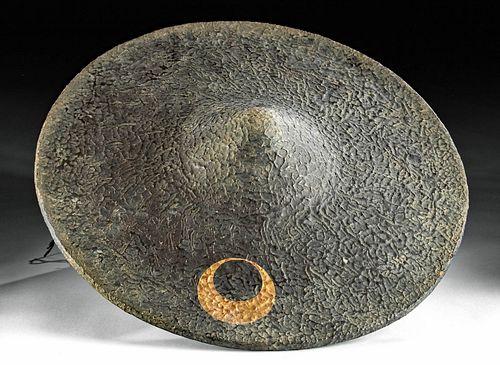19th C. Japanese Edo Lacquer Wood Samurai Jingasa Hat
Lot 26b
About Seller
Artemis Gallery
686 S Taylor Ave, Ste 106
Louisville, CO 80027
United States
Selling antiquities, ancient and ethnographic art online since 1993, Artemis Gallery specializes in Classical Antiquities (Egyptian, Greek, Roman, Near Eastern), Asian, Pre-Columbian, African / Tribal / Oceanographic art. Our extensive inventory includes pottery, stone, metal, wood, glass and textil...Read more
Categories
Estimate:
$800 - $1,200
Absentee vs Live bid
Two ways to bid:
- Leave a max absentee bid and the platform will bid on your behalf up to your maximum bid during the live auction.
- Bid live during the auction and your bids will be submitted real-time to the auctioneer.
Bid Increments
| Price | Bid Increment |
|---|---|
| $0 | $25 |
| $300 | $50 |
| $1,000 | $100 |
| $2,000 | $250 |
| $5,000 | $500 |
| $10,000 | $1,000 |
| $20,000 | $2,500 |
| $50,000 | $5,000 |
| $100,000 | $10,000 |
| $200,000 | $20,000 |
About Auction
By Artemis Gallery
Jun 24, 2021
Set Reminder
2021-06-24 10:00:00
2021-06-24 10:00:00
America/New_York
Bidsquare
Bidsquare : VARIETY SALE | Ancient & Ethnographic Art
https://www.bidsquare.com/auctions/artemis-gallery/variety-sale-ancient-ethnographic-art-7119
Featuring classical antiquities, ancient and ethnographic art. Egyptian, Greek, Roman, Etruscan, Near Eastern, Asian, Pre-Columbian, Native American, African / Tribal, Oceanic, Spanish Colonial, Russian, Fossils, Fine Art, more! All legally acquired, legal to sell. Satisfaction guaranteed. Artemis Gallery info@artemisgallery.com
Featuring classical antiquities, ancient and ethnographic art. Egyptian, Greek, Roman, Etruscan, Near Eastern, Asian, Pre-Columbian, Native American, African / Tribal, Oceanic, Spanish Colonial, Russian, Fossils, Fine Art, more! All legally acquired, legal to sell. Satisfaction guaranteed. Artemis Gallery info@artemisgallery.com
- Lot Description
East Asia, Japan, Edo to Meiji period, ca. late 19th to early 20th century CE. A black, lacquered wood jingasa or camp hat of a shallow circular form with a gold-hued family crest on the brim. The interior presents a central concave area for the wearer's head, with a padded cloth lining. Jingasa hats were worn by Japanese warriors during travel or encampment. Being lacquered, this jingasa was especially convenient as it was both waterproof and lightweight. During the Edo period, jingasa became more decorative, just like other samurai items, as they were increasingly used for display during sankin kotai. Size: 16" Diameter x 3.5" H (40.6 cm x 8.9 cm)
Sankin kotai, known as "alternate attendance," was developed during the Warring States period as a system to strengthen the Tokugawa shogunate's control over the feudal lords known as daimyos. The daimyo would alternate between residing in the shogun's castle in Edo and his own fief, usually on a yearly basis. However, while the daimyo may return to his home fief, his family was required to remain in Edo with the Shogun, essentially as hostages to ensure loyalty while the daimyo was away. When traveling to Edo the daimyo was accompanied by samurai and jingasa hats were worn during travel or encampment as a protective helmet. Being lacquered, this jingasa was especially convenient as it was both waterproof and lightweight. During the Edo period, jingasa became more decorative for these sankin kotai processions.
Provenance: ex-private Boulder, Colorado USA collection
All items legal to buy/sell under U.S. Statute covering cultural patrimony Code 2600, CHAPTER 14, and are guaranteed to be as described or your money back.
A Certificate of Authenticity will accompany all winning bids.
We ship worldwide and handle all shipping in-house for your convenience.
#162695Some surface wear with losses and chipping to lacquer, with loss at the periphery of rim. Family crest has some fading but still vibrant. Padded fabric lining is worn, stained, and shows minor losses. Sections of padding are loose from the hat. Minor fraying to ends of ties.Condition
- Shipping Info
-
All shipping is handled in-house for your convenience. Your invoice from Artemis Gallery will include shipping calculation instructions. If in doubt, please inquire BEFORE bidding for estimated shipping costs for individual items.
-
- Buyer's Premium



 EUR
EUR CAD
CAD AUD
AUD GBP
GBP MXN
MXN HKD
HKD CNY
CNY MYR
MYR SEK
SEK SGD
SGD CHF
CHF THB
THB













